This was published 2 years ago
Tokyo places to eat: Why Japan's capital is the world's best city for food
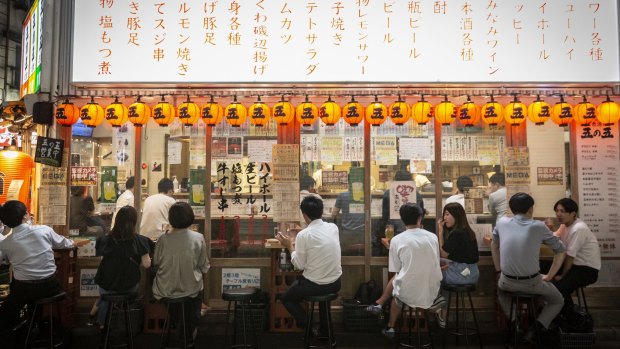
A bar in Ueno area of Tokyo. This is a city in which you could eat every meal for the rest of your life and you would never grow bored.Credit: Getty Images
There's no better place to eat in the world than Tokyo. There is no city so stupendously large, none so obsessed with culinary quality, none so ready to embrace such a range of cuisine. There is no competition. Tokyo is the best.
That's a big call, I understand, and one I've thought about often. So many other cities around the world offer sheer brilliance for the travelling gourmand: New York, Paris, Bangkok, Melbourne, San Sebastian, Shanghai, Mexico City …
The list goes on, and on any given day you could claim these as the finest and it wouldn't sound crazy. But Tokyo is something else entirely.
This is a city in which you could eat every meal for the rest of your life and you would never grow bored.
It's a city that has taken the concept of dining out and refined it, perfected it, given its complexity and dimension in the same way a great chef would build flavour in a classic dish.
It's a heady, intoxicating experience to arrive in the Japanese capital as a lover of good food and begin to wrap your head around just how much there is on offer in this place. Every bite here, every mouthful, is a pleasure.
Tokyo is the food capital of the world – and here, in this guide to eating and drinking in the Japanese capital, based on my new book, Neon Lights in Tokyo, I make the case for such a status.
THE SHEER SCALE OF TOKYO IS MIND-BOGGLING
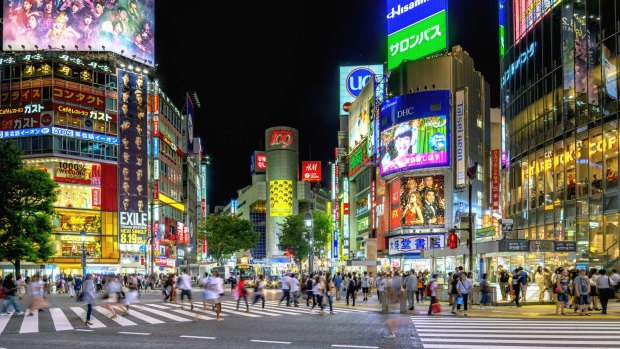
Credit: iStock
Greater Tokyo has a population of almost 40 million people. That's nearly twice as many people as Australia, in an area that's half the size of Sydney.
Such numbers bring a scale and diversity to the Tokyo food scene that just can't be matched anywhere else. Every conceivable style of cuisine – from dishes specific just to Tokyo, to the most obscure foreign idea – and every price-point has been covered in Tokyo multiple times over.
If you can eat it, you can find it in the Japanese capital. If you can drink it, you can find it here. These 40 million people all love food, they all love to dine out, and they all have an expectation of quality. It results in something truly amazing.
TOKYO THE HOME OF COUNTER-CULTURE
Dining is more than mere food in Tokyo, and in fact in all of Japan. It's theatre. It's performance. Most importantly, it's a deep sense of welcome and conviviality.
And it is all of these things because of counter-culture: that is, sitting at a broad wooden counter in a restaurant that only seats eight or 10 diners, the structure of so many of Tokyo's great eateries.
At a Tokyo counter, diners have a front-row seat to witness the best in the business prepare their food, slicing and poaching and grilling and steaming, all while engaging their customers in light-hearted chatter.
Chefs watch carefully as their diners eat; they judge their dishes' successes, and make subtle tweaks to the rest of the meal. And at the end they usher their customers out to the street, bidding farewell from the door, the ultimate sign of warmth and respect. There's nothing else like it.
THE FOOD HALLS OF TOKYO ARE INCREDIBLE
Pay scant attention to the clothes in a Tokyo department store, at the likes of Mitsukoshi (cp.mistore.jp), Isetan and Takashimaya (takashimaya-global.com). Walk right past the fragrances. Don't even consider the shoes.
Instead, find an escalator and head down to the basement levels, and prepare to be dazzled by the incredible amount of good food there is on offer. These department store food halls are known as "depachika", and they are heaven on Earth for anyone who likes to eat.
In these sprawling subterranean spaces you will find everything from gourmet bento boxes, to high-end fresh produce, to French-style bread, to beautiful chocolates, to luxury items imported from around the world, to local sake and whisky and much more. Bring cash, or credit cards, and prepare to spend.
EVEN TOKYO'S CONVENIENCE STORE FOOD IS GOOD
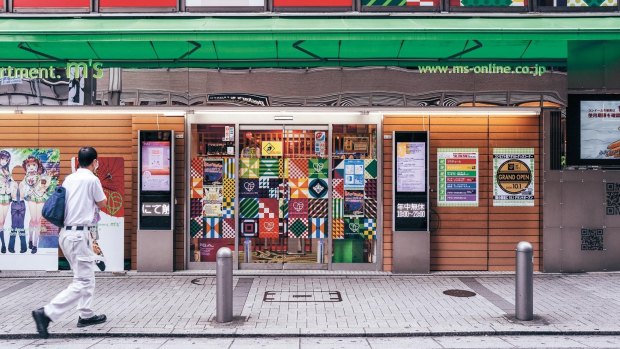
In any normal country, any normal city, you'd hardly set foot inside a convenience store if you were looking for something good and fresh to eat. And yet the food in a Tokyo "konbini" is surprisingly delicious, and eminently affordable.
You could call into a Lawson, a FamilyMart or even a 7-Eleven, outlet simply to get your hands on one of their famous "tamago sandos", or egg salad sandwiches.
But you could also grab an onigiri, or flavoured rice ball, a little bento box of, say, sushi or katsu and sides, a gyudon, or beef-and-rice bowl, or even soba noodles with dipping sauce. Pair these with a $3 konbini beer and you have yourself an exceptionally good, cheap meal.
TOKYO IS THE HOME OF THE IZAKAYA
Everyone knows about Spanish tapas bars. But how many people realise that Japan has a similar culture of small-plate dining, of food designed to be paired with alcoholic drinks and good times?
That's the izakaya, a casual Japanese tavern, a cosy, friendly place that is all about the consumption of sake and beer with small portions of extremely good food.
Tokyo is absolutely awash with izakaya, with literally tens of thousands strewn across its length and breadth, ranging from the cheapest "tachinomi", or standing bar, to izakaya such as Azabu Rokkaku that boast a Michelin star.
EVERY CUISINE IS BETTER IN TOKYO
Obviously, the local Japanese cuisine in Tokyo is exceptional. But one of the signs that this is a city of gourmands, of talented cooks who take their craft uber-seriously, is that every country's cuisine is done well in Tokyo.
In fact, in the case of French and even Italian, you could argue that the Japanese do it better than the original. Just try the Naples-style pizza at the likes of Pizza Studio Tamaki (pst-tk2-ad.com), or the seriously tasty Japanese-style "wafu" pasta at Kabe no Ana (kabenoana.com) in Shibuya and tell me I'm wrong.
Or splash out on French cuisine in Tokyo that is as high-end as high-end gets, at the three-Michelin-starred likes of Quintessence (quintessence.jp), L'Effervescence (leffervescence.jp) and L'Osier (losier.shiseido.co.jp). No one does it better.
SUSHI IS AN ART FORM IN TOKYO
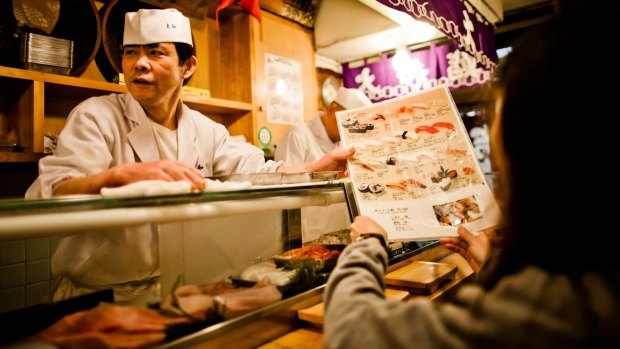
. Credit: Getty Images
There are roughly three tiers of sushi restaurants in Tokyo, and the further up you go, the more you'll have to concern yourself with the following rules. For the cheapest "kaitenzushi", or conveyor belt sushi restaurant, it's an anything-goes atmosphere.
At the fancier a la carte places you will need to observe a few niceties, and at the high-end, omakase-style restaurants, be aware that the following etiquette rules are very important.
Book a coveted seat at a high-end sushi restaurant in Tokyo and prepare to be wowed by something that is akin to performance art, a carefully choreographed show of slicing, moulding and placing, a tour de force of the freshest and finest seafood in the world, paired with the best seasoned rice.
A sushi "itamae", or chef, is the centre of attention at any good sushi restaurant, as diners huddle around the cypress-wood bar and watch as 20 or 30 courses of bite-sized perfection are prepared and served. Every movement made has been practised or decades and every progression throughout the meal has been carefully considered. It's all mind-blowingly complex, and yet eminently enjoyable. Sample this style of sushi at restaurants such as Kyubey (kyubey.jp), and Sushi Rinda (shortstop-sushi.com).
RAMEN IS LIFE IN TOKYO
I will never forget the Tokyo Airbnb I stayed in once, which included a folder filled with restaurant recommendations in the local area. On the first page, the host had written: "Ramen, ramen, ramen – always on my mind."
And she is surely not alone in that obsession, because it appears Tokyo as a whole has its mind on this ultimate noodle soup dish, with its infinite possibility for variation and deliciousness. There are so, so many ramen shops in Tokyo. You will never end your search for good ramen.
There's old-school and new-school, fancy and no-frills, Tokyo-style ramen, miso ramen, curry ramen, even vegan ramen at the likes to T's Tantan (tsrestaurant.jp), and Vegan Ramen UZU Tokyo (vegan-uzu.com).
Tokyo's ramen stores usually sell only one or two different styles, which they have perfected over many years and countless hours. And most will cost no more than $10-$15. Ramen, ramen, ramen – always on my mind.
IN TOKYO THERE'S A RESTAURANT FOR EVERY BUDGET
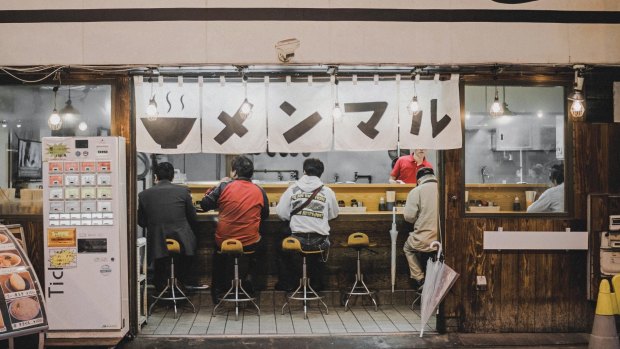
This may just be the biggest advantage of a city of 40 million: there's a restaurant of every style for every budget. Every niche of cuisine here, from yakitori (grilled poultry) to yakiniku (grilled meat) to katsu (deep-fried pork cutlets) to sushi to tempura and many more, works on a sliding scale, from low-budget to high-end and all points in between.
Take yakitori, for example. If you want cheap-and-cheerful yakitori, grilled chicken skewers and beer with little fuss, you could roll up to any of the raucous restaurants that sit under the train line in Yurakucho, near Ginza.
Or, if you wanted the absolute best yakitori, a restaurant that elevates this cuisine to the truly gourmet, you could visit Torisawa (no website), a famed yakitori den in Kameido. Or if you wanted somewhere in the middle of those options, you could try Fuku Yakitori (sumibikushiyakifuku.com) in Yoyogi-Uehara; refined but accessible.
And you have this range to choose from for every single style of Japanese (and usually foreign) cuisine. You can spend exactly as much as you wish, and you will always get your money's worth.
YOU CAN TOUR JAPAN ON A PLATE IN TOKYO
The Japanese are obsessed with hyper-local produce, with the specialities of a particular prefecture, an area of Japan that does, say, ice-cream better than anyone. Or apples better than anyone. Or rice better than anyone.
To cater to this need, Tokyo boasts a series of "antenna stores", shops that specialise in the produce of a certain prefecture. Many of these can be found in Ginza and Yurakucho.
Highlights include Hokkaido Dosanko Plaza, which is chock full of Hokkaido's famous dairy and seafood; Ginza Nagano Shop (ginza-nagano.jp), which does tastings of Nagano wine; Omotesando Niigatakan N'espace (www.nico.or.jp), with Niigata rice and sake; and Nihonbashi Fukushimakan Midette (midette.com), with specialty sake and dried fruits from Fukushima.
THE CLASSICS REMAIN INTACT IN TOKYO
Take a quick glance at Tokyo and it will seem as if there's a headlong rush towards modernity, that everything has to be new and sparkly to catch anyone's attention. But that's not true at all, particularly when it comes to food: there's deep respect here for tradition, for the classics, for the pioneers.
Multiple restaurants in this city have histories that stretch back more than 100 years. Take Nihonbashi Iseju (iseju.com), a sukiyaki specialist that has been in business since 1869. Or Asakusa Sushisei (sushisei.owst.jp), which has served Edo-style sushi since 1891.
There's also Namiki Yabusoba (yabusoba.co.jp), an Asakusa-based noodle restaurant in business for more than a century; Dote no Iseya (dotenoiseya.jp), which has been dishing out huge tempura-don bowls since 1873; Tonki (no website), which pioneered pork katsu back in 1939; and Harukiya (haruki-ya.co.jp), one of the first wave of ramen restaurants in 1949.
COFFEE CULTURE IS BOOMING IN TOKYO
Tokyo's coffee culture has come in waves – four, at latest count. The first wave was the introduction of kissatens, traditional tea rooms that began serving basic coffee-with-milk back in the early 20th century.
Next came the wave of American-style chain cafes, such as Starbucks and Tully's, and their local imposters, namely Doutor and Excelsior Caffe, which, to be honest, are fairly horrendous.
More recently, there's been a third wave of Japanese coffee in the form of independent cafes serving Italian-style (and Australian-style) espresso, meaning you can get an excellent flat white at the likes of Onibus in Nakameguro (onibuscoffee.com), or Path in Tomigaya.
And now, you could argue that Tokyo has a fourth wave of coffee snobbery: the American-style pour-over, taken to extreme levels of greatness by local Japanese obsessives. Try this coffee at Arise Coffee Roasters in Kiyosumi (arisecoffee.jp), or Heart's Light Coffee in Shibuya (heartslightcoffee.stores.jp).
This story is an extract from the author's new book, Neon Lights in Tokyo. It's a comprehensive insight into the passions of a city and its 40 million residents, providing a window into Tokyo dining and drinking as well as fashion, design, history and more. It's available now at bookstores RRP $32.99. See hardiegrant.com/au
FIVE ESSENTIAL TIPS TO EAT WELL IN TOKYO
BOOK WELL AHEAD
Most high-end Tokyo restaurants require booking several weeks in advance with many only accepting phone booking with little website functionality. Make izakaya and restaurant bookings either using the foreigner-friendly TableAll (www.tableall.com) or Pocket Concierge (pocket-concierge.jp) websites. If you're staying in a hotel, ask the concierge to make a phone booking for you.
DON'T OVER-PLAN
Yes, it's certainly worth booking in a night or two at one of the Japanese capital's bucket-list restaurants, but you should also leave plenty of space for spontaneity. Tokyo has so many great places to eat, so many wonderful venues to stumble upon, that it would be a shame to lock yourself in for too many meals.
VISIT DEPARTMENT STORES
Stuck for somewhere to eat? Just want a restaurant that allows walk-ins, that caters to families, and that will serve food that is reliably delicious but not too expensive? Then visit a department store. Pretty much all Tokyo department stores dedicate their top two levels to dining, and the restaurants in these spaces are all affordable, approachable, varied and delicious.
EAT AT APPROPRIATE TIMES
The bulk of Tokyo's citizens eat at fairly strict times, and it will pay to observe these times if you want to enjoy the best food. Plan to eat lunch before 1pm, and dinner before 8pm. For late-night eats, try ramen bars and izakaya, which tend to stay open until about 11pm. And bear in mind that breakfast and brunch options are limited.
GO OUT FOR LUNCH
Here's a vital piece of knowledge for those dining in Tokyo: the city's high-end restaurants tend to charge less for lunch than they do for dinner. Same food, same level of service, lower prices. If you want to sample Tokyo fine-dining but are trying to keep your budget under control, book lunch, not dinner.
Sign up for the Traveller Deals newsletter
Get exclusive travel deals delivered straight to your inbox. Sign up now.